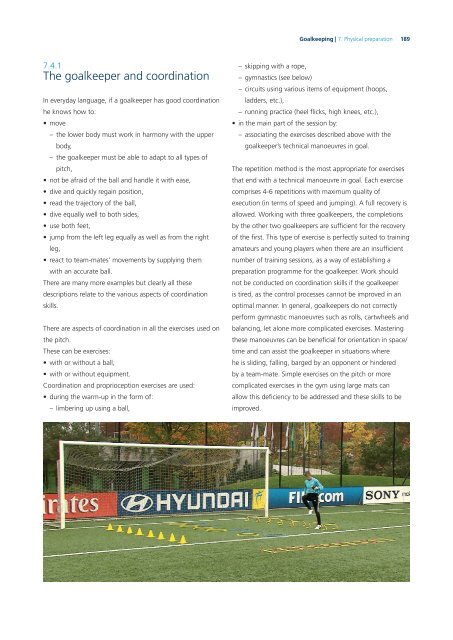Goalkeeping-bok
Goalkeeping-bok
Goalkeeping-bok
You also want an ePaper? Increase the reach of your titles
YUMPU automatically turns print PDFs into web optimized ePapers that Google loves.
7.4.1<br />
The goalkeeper and coordination<br />
In everyday language, if a goalkeeper has good coordination<br />
he knows how to:<br />
• move<br />
– the lower body must work in harmony with the upper<br />
body,<br />
– the goalkeeper must be able to adapt to all types of<br />
pitch,<br />
• not be afraid of the ball and handle it with ease,<br />
• dive and quickly regain position,<br />
• read the trajectory of the ball,<br />
• dive equally well to both sides,<br />
• use both feet,<br />
• jump from the left leg equally as well as from the right<br />
leg,<br />
• react to team-mates’ movements by supplying them<br />
with an accurate ball.<br />
There are many more examples but clearly all these<br />
descriptions relate to the various aspects of coordination<br />
skills.<br />
There are aspects of coordination in all the exercises used on<br />
the pitch.<br />
These can be exercises:<br />
• with or without a ball,<br />
• with or without equipment.<br />
Coordination and proprioception exercises are used:<br />
• during the warm-up in the form of:<br />
– limbering up using a ball,<br />
– skipping with a rope,<br />
– gymnastics (see below)<br />
<strong>Goalkeeping</strong> | 7. Physical preparation<br />
– circuits using various items of equipment (hoops,<br />
ladders, etc.),<br />
– running practice (heel fl icks, high knees, etc.),<br />
• in the main part of the session by:<br />
– associating the exercises described above with the<br />
goalkeeper’s technical manoeuvres in goal.<br />
189<br />
The repetition method is the most appropriate for exercises<br />
that end with a technical manoeuvre in goal. Each exercise<br />
comprises 4-6 repetitions with maximum quality of<br />
execution (in terms of speed and jumping). A full recovery is<br />
allowed. Working with three goalkeepers, the completions<br />
by the other two goalkeepers are suffi cient for the recovery<br />
of the fi rst. This type of exercise is perfectly suited to training<br />
amateurs and young players when there are an insuffi cient<br />
number of training sessions, as a way of establishing a<br />
preparation programme for the goalkeeper. Work should<br />
not be conducted on coordination skills if the goalkeeper<br />
is tired, as the control processes cannot be improved in an<br />
optimal manner. In general, goalkeepers do not correctly<br />
perform gymnastic manoeuvres such as rolls, cartwheels and<br />
balancing, let alone more complicated exercises. Mastering<br />
these manoeuvres can be benefi cial for orientation in space/<br />
time and can assist the goalkeeper in situations where<br />
he is sliding, falling, barged by an opponent or hindered<br />
by a team-mate. Simple exercises on the pitch or more<br />
complicated exercises in the gym using large mats can<br />
allow this defi ciency to be addressed and these skills to be<br />
improved.


